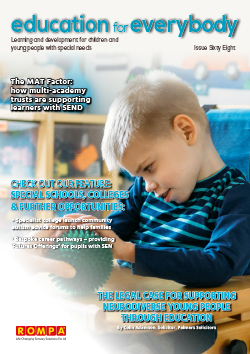January to June is a key time for school recruitment and for roles working with people with special needs and disabilities as the New Year is often when management teams turn their eye to planning for the next academic year. But how do you make your SEND teacher application stand out from the crowd at a time when everyone is looking for a new job? We caught up with professionals in SEND recruitment to ask their tips on how to write successful job applications for these types of roles.
Start with the basics
Kelly Woollard is the lead SEND consultant at Clarus Education, one of the UK’s largest education recruitment companies. She deals with hundreds of teaching job applications every week and has the following advice.
“My first tip is to get the basics right. A good application will use clear written English with correct spelling and grammar and will be laid out neatly. It sounds obvious but when I’m sifting through applications, you’d be surprised at how many have mistakes or a messy layout. They immediately stand out for all the wrong reasons.Â

“Next you need to think about crafting a good personal statement. This will set your stall from the outset. Highlight your ambition and passion, key achievements, outcomes and impact for children. Selling yourself is something that a lot of people can feel uncomfortable about, but the way to get around it is to approach it as though you are talking about somebody else. Ask your friends, relatives or former colleagues for ideas about what they think you’re good at. Business networking sites like LinkedIn are also a great place to get professional recommendations, so use (and actively seek out) endorsements from here and paraphrase them on your application.
“If you feel uncomfortable about asking people for help, consider how you would feel if the shoe was on the other foot – the fact that you work in education, and particularly in SEND, means that it’s probably in your nature to want to help others; it’s likely you will find that your own network will feel the same.
“In terms of layout, bullet points are a good option. We get hundreds of applications for each role, so remember the person reading yours is likely to have seen quite a few. Anything that keeps it short, snappy and to the point is a winner. Highlight any extra curriculum activities you can do such as languages, Duke of Edinburgh, sports clubs etc.
“Photos can be a good idea and can make your application stand out, but it needs to be a head and shoulders shot that looks professional. A cropped photo from a night out is not the way to go.â€
Tailor your application to the specific SEND teacher role
Amy Allen, founder of Senploy, the UK’s first jobsite dedicated to special educational needs and disabilities roles, has this advice:
“You’ll probably know from experience that SEND teacher jobs often require application forms either as well as (or instead of) sending a CV. Often it’s because SEND teacher roles are publicly funded based at schools, colleges, councils and within the NHS, where it’s an integral part of the HR process. It’s also a way of the organisation gauging if your personality suits the type of role you’re applying for.
“In our industry, more so than others, it’s essential to write an application that’s bespoke to the role. It can be difficult to stay motivated if you’ve written multiple job applications already, but by tailoring your application to the specific organisation you’ll make yourself stand out as somebody who is aligned with their vision and values. Read up on their mission statement and company ethos and demonstrate how you ‘fit’ with these.

“As well as qualifications and experience, demonstrating ‘softer skills’ like empathy, patience and understanding are just as important for roles in the SEND industry, so potential employers will often ask you to fill in an application form with questions geared towards assessing these areas. Here is a chance to showcase your personality, the unique qualities you have that will mean you’ll excel in a role working with people with special needs and disabilities. I’d always try to weave in some real-life examples here – obviously it’s great if they’re work related but you can use situations from your personal life if they’re appropriate. Think outside the box!Â
“Another tip is to be wary of jargon, our industry uses lots of acronyms which can make you look unprofessional if you get them wrong. Use correct and up to date SEND terminology then check and double check to make sure your using the right abbreviations. And if you’re not sure, use a full description. My one rule is to never guess as that could leave you looking unprofessional.
“When adding any training use the correct qualification like Team Teach, don’t abbreviate to TT. Always state the date you undertook the training as some qualifications need refreshing.â€
Senploy is the UK’s first dedicated job site for careers in the special educational needs and disability sector, the website is packed with helpful advice for those looking for SEND teacher roles.






